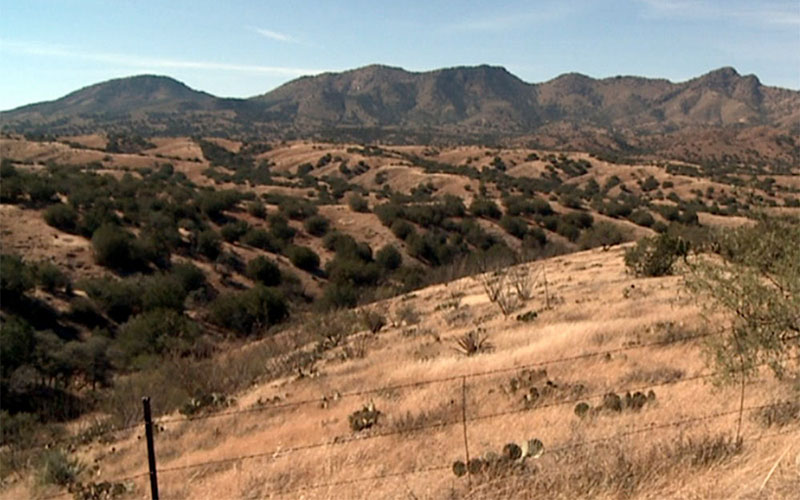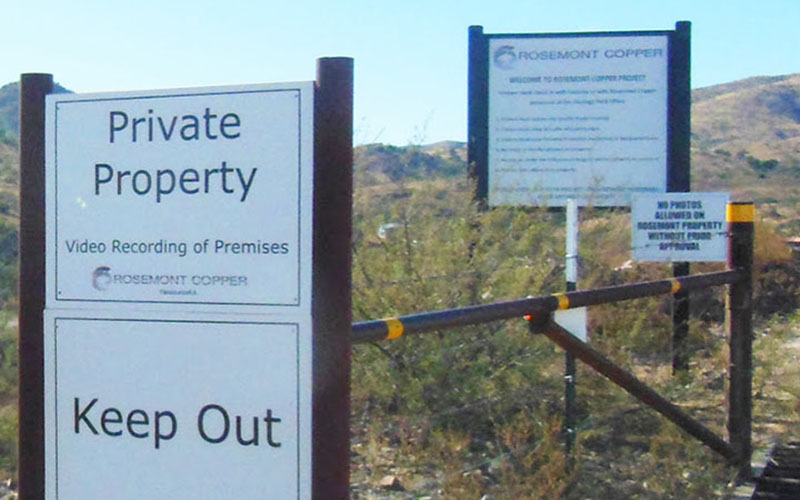
Opponents of the Rosemont copper mine, which would be situated here in the Santa Rita Mountains, said not enough study has been done on the proposed mine’s environmental impacts. (Photo by Rob Scott/Cronkite News)

The entrance to the site of the proposed Rosemont Copper Mine, about 30 miles southeast of Tucson. If approved, the pit min here could be a mile wide and 1.5 miles long. (Photo courtesy GoogleEarth)
WASHINGTON – Environmental groups sued the Forest Service this week to block what they called the “dangerous” Rosemont copper mine, citing concerns ranging from habitat destruction to drinking water contamination at the project southeast of Tucson.
The Forest Service said Tuesday it will not comment on pending litigation. But Hudbay Minerals, the Canada-based parent company of the Rosemont Copper Mine, said it expects the suit will fail, the latest in “one of many legal challenges in the permitting process.”
The 75-page suit, filed Monday in U.S. District Court in Tucson, is the latest in at least a decade’s worth of challenges to the proposed pit mine in the Santa Rita Mountains that would be a mile wide, 1.5 miles long and more than 3,000 feet deep.
The suit – by the Center for Biological Diversity, the Sierra Club, the Arizona Mining Reform Coalition and a group called Save the Scenic Santa Ritas – claims that the Forest Service did not review the proposed mine, consistent with over a dozen state and federal regulations, including the National Environmental Policy Act (NEPA).
“If the economic and environmental review were done consistent with federal law, including NEPA, the federal government would have found that this is not the right mine, and not the right place,” said David Steele, a spokesman for Save the Scenic Santa Ritas.
The lawsuit said there was not enough analysis on the impact of the mine – which it said would use “about 4.8 million gallons per day, mostly supplied by groundwater wells in the Santa Cruz Valley” – on surrounding aquifers and water supplies. Opponents said water supplies are at risk of pollution and irreversible depletion in the arid region.
They also pointed to the final environmental impact statement, which noted that modeling on the mine pit lake “indicate that various contaminant levels that would result from these mining processes may exceed surface water quality standards for wildlife.”
“What this is, is a foreign mining company taking the water from a very arid region to wash rocks – that’s what they are basically doing,” Steele said. “The impacts will be devastating to the environment and to surrounding communities.”
In a prepared statement Monday, Hudbay flatly rejected the claims raised in the lawsuit.
“Rosemont has been under review for nearly a decade and considered in that time by 17 cooperating agencies, mostly at the federal and state levels,” the statement said. “The project record, which culminated in the Record of Decision, includes nearly 50,000 technical reports and references.”
A 2009 study by Arizona State University’s W.P. Carey School of Business estimated that the mine would result in about $27 billion in economic impact over its life of “20-plus years” and the creation of 4,500 jobs.
But Steele said the project has “air-quality implications, and it puts endangered animals including the jaguar at risk.” That was echoed by the Center for Biological Diversity, which has a separate suit against the U.S. Fish and Wildlife Service over the mine that it said “would permanently destroy endangered species habitat.”
“The Forest Service should be working to protect rivers, streams and wildlife in the Coronado National Forest, not greenlighting this destructive project,” said Marc Fink, a senior attorney with the center, in a news release on the latest suit.
The mine is still awaiting Army Corps of Engineers approval of a clean water permit, making the Forest Service approval of the project premature, said Arizona Mining Reform Coalition Director Roger Featherstone.
“The Forest Service isn’t allowed to grant the mine permits unless it is in accordance with all other agencies and permits,” Featherstone said. “So it’s kind of silly for them to grant a permit when the Army Corps has given every indication that they plan on denying the permit.”
Edward Coffey, a spokesman for the Army Corps of Engineers South Pacific Division, said the agency was “still deliberating” whether or not to grant the permit. He said the Corps provides input to the Forest Service, which can make its decision at any time.
Featherstone said his organization is not against all mining, but “that there are some places that should just never be mined – and this is one of those places.”